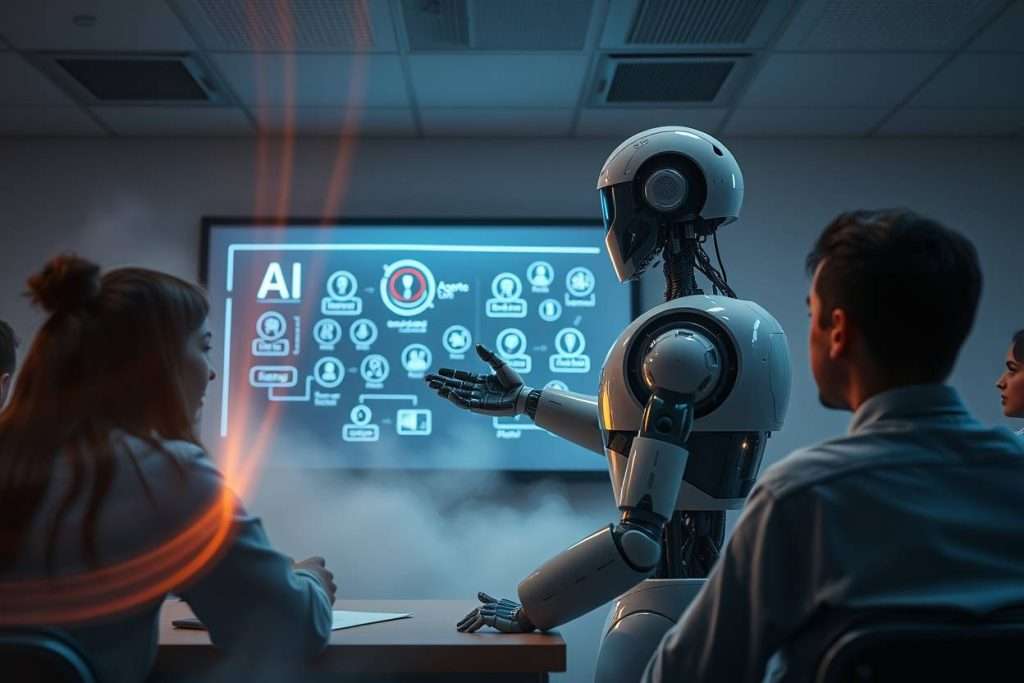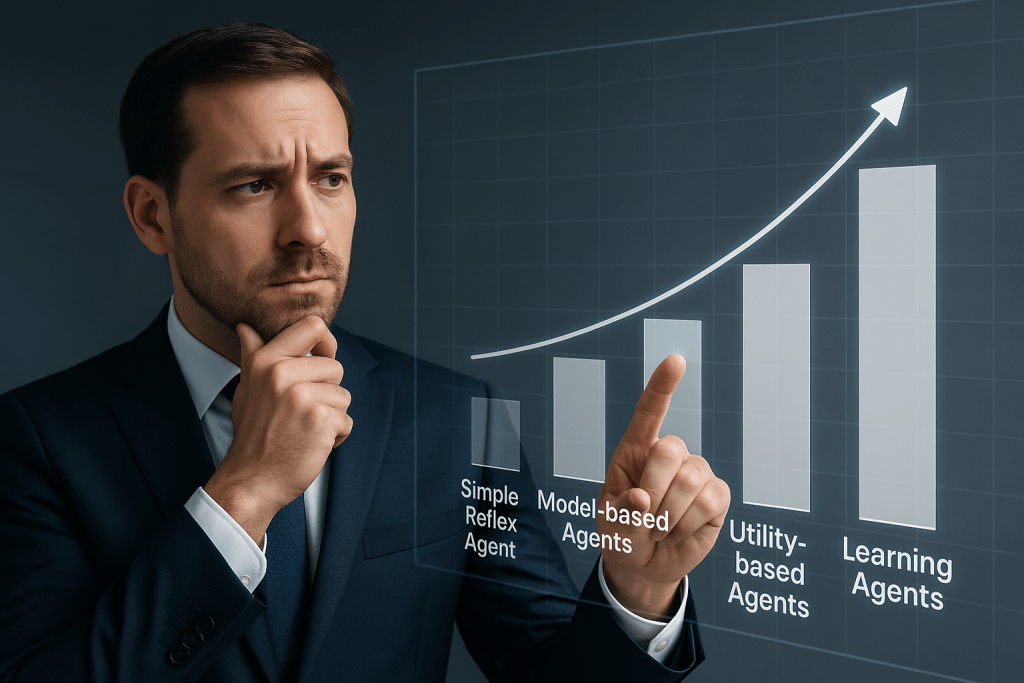Model-Based Reflex Agents: The Engine Behind Conversational AI

What Is a Model-Based Reflex Agent?
Model-Based Reflex Agent: An autonomous AI system that maintains an internal model of its environment, built from accumulated perceptions and experiences. This internal representation enables the agent to make informed decisions even when current sensor data is incomplete or unavailable, as it can reference its stored knowledge of how the world works to fill in gaps and predict unseen states.
This guide provides a practical analysis of Model-Based reflex agents. We will explore their core mechanisms, detail their most effective business applications, and provide a clear framework for understanding their critical advantages and limitations. This knowledge is essential for any leader aiming to implement intelligent, context-aware automation.
What is the core characteristic of a model-based reflex agent?
The defining characteristic of a model-based reflex agent is its statefulness. Unlike simpler agents that only react to current stimuli, a model-based agent uses its memory of “how the world works” to make more intelligent and context-aware decisions.
How does a model-based agent actually work?
The agent functions through a “Perceive-Model-Act” cycle, an enhancement of the simple reflex loop:
- Perceive: The agent uses its sensors to gather new information from its environment.
- Model: It updates its internal state (its memory or model) by combining the new sensory information with its existing knowledge of the world. This step answers the question, “How has the world changed?”
- Act: The agent’s decision-making logic uses this updated internal model to select and execute the most appropriate action via its actuators.
This ability to maintain and update an internal model is what allows the agent to handle context and ambiguity.
Where are Model-Based Agents Used in Business?
Model-Based Reflex Agents are deployed wherever context and memory are necessary for a task. Their most common application is in conversational AI, but they are also used in monitoring and basic robotics.
Why are chatbots the most common example of model-based agents?
Modern chatbots are the quintessential model-based agents. Their effectiveness depends entirely on their ability to maintain context throughout a conversation.
- Conversational Context: The agent’s internal model stores the history of the dialogue. When a user asks a follow-up question like, “What about in blue?” the agent uses its memory of the previous turn (“I’m interested in the ‘Trailblazer’ jacket”) to understand the query and provide a relevant response.
- Personalization: For logged-in users, a chatbot can use its model of the user’s past purchase history to offer more tailored recommendations. Research from Salesforce shows that 38% of customers are comfortable with agents creating personalized content
How are model-based agents used in monitoring and diagnostics?
- System Performance Monitoring: An IT monitoring agent uses an internal model of a server’s normal performance behavior. By tracking metrics over time, it can distinguish between a harmless, temporary spike in CPU usage and a sustained, problematic trend that requires a human administrator’s attention.
- Medical Triage (Simple): A basic diagnostic chatbot asks a patient a series of questions. It uses the answers from previous questions (e.g., “Do you have a fever?”) to determine the next logical question to ask (e.g., “How high is the fever?”), progressively refining its understanding of the situation.
What are some applications in robotics and navigation?
- Simple Autonomous Robots: A robotic vacuum cleaner builds a map—an internal model—of a room as it moves. This allows it to remember which areas it has already cleaned and to navigate more efficiently on subsequent runs.
- Basic Drone Navigation: A drone flying in an urban canyon might temporarily lose its GPS signal. It can use a model-based system, combining its last known GPS coordinates with data from its inertial sensors (like accelerometers), to estimate its current position and maintain a stable flight path.
What Is the Primary Advantage of a Model-Based Reflex Agent?

The core advantage of a model-based agent is its ability to function effectively in environments that are not fully observable.
How does the internal model allow for better decision-making?
- Handling Partial Observability: The agent can use its internal model to “fill in the blanks” when its sensors cannot see the full picture. It makes an educated guess about the state of the world based on its memory.
- Understanding Cause and Effect: By tracking how its own actions (and external events) change its environment, the agent begins to build a rudimentary understanding of causality. For example, it learns that when it sends a “password reset” email, the user’s “locked-out” status changes to “active.”
What is the business value of this capability?
- Improved Customer Experience: The ability to hold a coherent, context-aware conversation leads directly to higher customer satisfaction. Engaged customers buy more, are more loyal, and are cheaper to serve.
- More Accurate Monitoring: In IT and industrial settings, the agent’s ability to understand trends reduces the number of false alarms, allowing human operators to focus only on genuine issues.
What Are the key Limitations of Model-Based Agents?
While a significant step up from simple reflex agents, model-based agents have a critical limitation that prevents them from performing complex business automation.
Why can’t a model-based reflex agent perform complex business processes?
The reason is a lack of a goal and planning capability.
- It Is Purely Reactive: A model-based agent is sophisticated in how it perceives the present moment, but it has no concept of a future objective. It can react intelligently, but it cannot work towards a long-term goal.
- No Planning Capability: Because it has no goal, it cannot create a multi-step plan. It can only decide on the single best action for the current moment based on its internal model. This means it cannot execute a workflow like processing an insurance claim or onboarding a new employee.
What are the technical challenges in building a model-based agent?
- Model Accuracy: The agent’s performance is entirely dependent on the accuracy of its internal model. If the model’s representation of the world is incorrect, the agent’s actions will also be incorrect.
- Keeping the Model Updated: In a rapidly changing environment, ensuring the agent’s internal model stays synchronized with the real world can be a complex and computationally expensive engineering challenge.
How Do Model-Based Agents Compare to Other Agent Types?
Understanding where model-based AI agents fit in the hierarchy of agent types is key to selecting the right technology.
What is the key difference between a model-based agent and a simple reflex agent?
The defining difference is memory.
- A simple reflex agent is stateless. It has no memory and can only react to the immediate present.
- A model-based agent is stateful. Its memory allows it to understand context, making it far more versatile.
What is the main difference between a model-based agent and a goal-based agent?
The main difference is proactivity versus reactivity.
- A model-based reflex agent reacts to the present. It excels at tasks like conversation and diagnosis.
- A goal-based agent plans for the future. It is designed to execute multi-step workflows to achieve a specific business objective. For example, a model-based agent can talk to you about booking a flight, but a goal-based agent can actually book the flight.
What Are the Common Misconceptions About Model-Based Agents?
The widespread use of chatbots has led to some common misunderstandings about the capabilities of the underlying technology of AI agents.
Myth #1: Any chatbot is a sophisticated AI.
The Reality: While they are a major improvement over simple reflex agents, the model-based agents that power most chatbots are still one of the simpler forms of AI. They lack the critical planning and goal-oriented capabilities of more advanced agents, which are necessary for true business process automation.
Myth #2: A model-based agent can learn on its own.
The Reality: This is incorrect. A standard model-based agent operates using a pre-programmed model and rules. It can update its understanding of the current situation, but it cannot autonomously improve its own underlying logic or decision-making processes. That capability requires a more advanced Learning Agent.
When Should Your Business Choose a Model-Based Agent?

A model-based agent is the right choice when a task’s success depends on understanding context, but does not require the agent to complete a multi-step process.
What is the ideal use case for this type of agent?
You should choose a model-based agent under these conditions:
- When the primary function is conversational or diagnostic.
- When the task requires memory and context to handle interactions correctly.
- When the environment is partially observable, and the agent needs to infer the current state based on past events.
When should you choose a more advanced agent?
You should invest in a more advanced agent type if your business needs require any of the following:
- The agent must achieve a specific, long-term goal.
- The agent needs to plan and execute a sequence of actions (a workflow).
- The agent must choose the most efficient or profitable outcome among several options, which requires a Utility-Based Agent.
Ultimately, Model-Based Reflex Agents are a critical technology for any business looking to improve customer interactions and monitoring systems. While they are not the solution for end-to-end process automation, their ability to understand context makes them an essential component of the modern AI toolkit. If you are still unsure of the inner workings, potential and use cases, we wrote an in-depth guide on agentic AI for non-technical users.




